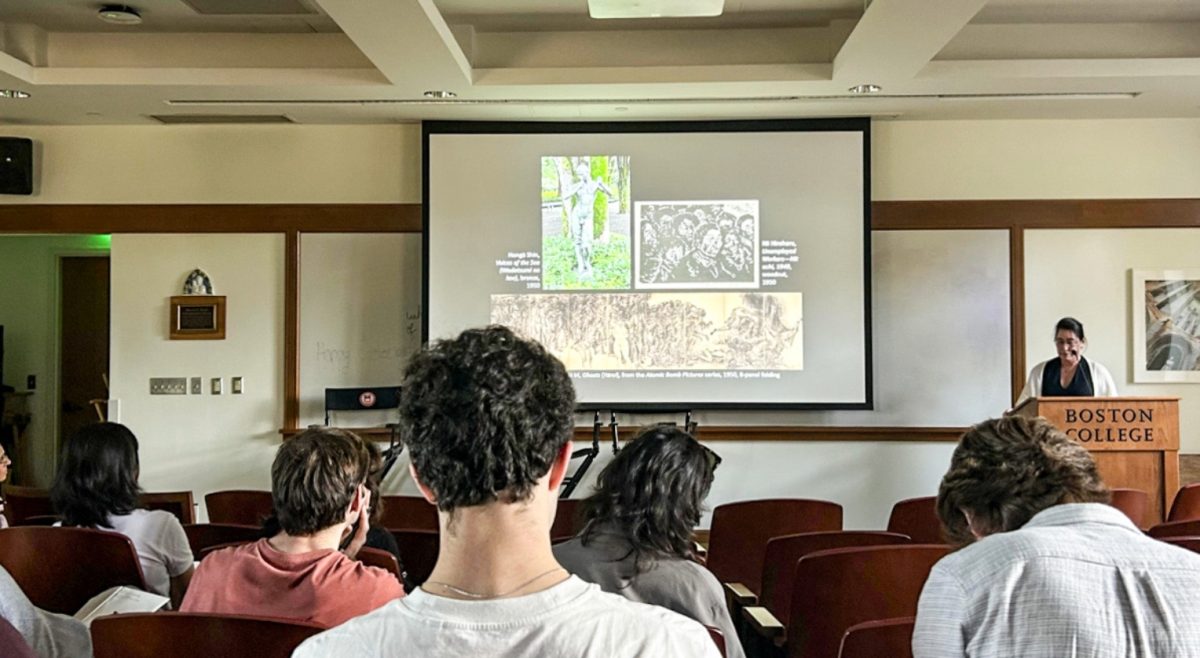Meredith Smith, A&S ’16, founded Mentoring Through the Arts as a response to budgetary cuts to local arts programs.
Public schools have grappled with the difficult decision of which programs to cut in half in order to accommodate budget reductions, and arts programs are often the first to go. It was the reduction—or in some cases, complete absence of arts and music programs in low-income elementary schools that compelled Meredith Smith, A&S ’16, to propose a mentorship program in the spring of her sophomore year at Boston College.
Under the advisement of Volunteer And Service Learning Director Dan Ponsetto, Smith originally pitched Mentoring Through the Arts as part of the Shaw Leadership Program. With a lack of federal funds, local schools were relying more on non-profit organizations and volunteering programs to set aside funding for arts education. Smith then took her ideas back to Ponsetto and created her own program once her original proposal was denied.
“Having a positive way to express emotion and creativity is beneficial to learning, but unfortunately, is difficult to find in schools,” Smith said. “I decided BC could bring the creative outlet by providing arts and crafts time and lessons to children in K through 4 at local sites.”

The Mentoring Through the Arts program focuses primarily on two locations: Charlesview Community Center in Allston and Edison K-8 School in Brighton. As part of the after-school programming, BC students volunteer on Friday afternoons to instruct elementary students on crafts, music, dance, and photography.
While both sites incorporate art projects and offer an outlet for creative expression, the program at Edison functions as more of a structured mentorship where BC students serve as role models and often help children with their schoolwork after class. At the recently constructed Charlesview Center, however, BC has been fully integrated into their culture.
“Charlesview was brand-new when we began last October,” Smith said. “The children and parents know that BC students come each Friday for art projects and time spent bonding.”
For Smith, the children themselves were the reasoning for the program’s inception. Both the Charlesview Center and Edison School do not incorporate arts programs into their in-class instruction and rely on Mentoring Through the Arts for a way for the students to channel their creativity in a positive way. “The children are lights in my week, something I look forward to probably more than they do,” Smith said . “To see them run up and ask about the craft for the day, or to tell our volunteers all about their week, has reinforced all of the reasons I wanted to start the program in the first place.”
Currently, Mentoring Through the Arts is headed by Amy Gribaudo, a graduate assistant at the Volunteering and Service Learning Center and LGSOE ‘15. Like Smith, Gribaudo derives tremendous inspiration from the students themselves and sees the mentorship program as a mutually beneficial experience between BC and elementary students alike.

“We focus so much on tests and being competitive that we don’t have time for [the students] to have fun without a grade,” Gribaudo said. “Arts lets them be themselves. No one is judging them on whether their work is good or bad.”
Through the volunteer arts program, BC students are afforded the opportunity to work with children from low-income areas and positively impact their creative development and overall learning experience. Gribaudo saw the mentoring program as an ideal way for young college students and children to gain insight from working with one another.
“Children have no previous perceptions and are so carefree,” Gribaudo said. “Everyone wants to be connected or involved—working with them allows college students come back to reality and put the BC world aside for a few hours.”
Gribaudo describes the programs in Mentoring Through the Arts as coinciding with specific holidays. With Halloween and Thanksgiving fast approaching, students are busy at work creating paper turkeys or decorating pumpkins. Accordingly, Gribaudo emphasizes that the children seem to take a particular interest in the crafts above all else, but she hopes to eventually integrate photography and other technological fields into the programming.
When asked about their aspirations for the arts program in the future, both Smith and Gribaudo expressed a desire for expansion to more sites, increased student involvement, and the display of the children’s artwork.
“I saw a great way to combine what I love in working in schools and with children and the ways art helps children find productive and positive areas of expression,” Smith said. “I would love to see collaboration among this group and other service or art groups on campus and participation by the children in community events to raise awareness for the cuts to art programs in schools.”
Programs like Mentoring Through the Arts have been vital, in recent years, as a supplement or alternative for a formal arts programs, offering students an education their school might otherwise leave out. “We focus so much on tests and being competitive that we don’t have time for them to have fun without a grade,” Gribaudo said. “Arts lets them be themselves—no one is judging them on whether their work is good or bad.”
Featured Image by John Wiley / Heights Editor


















